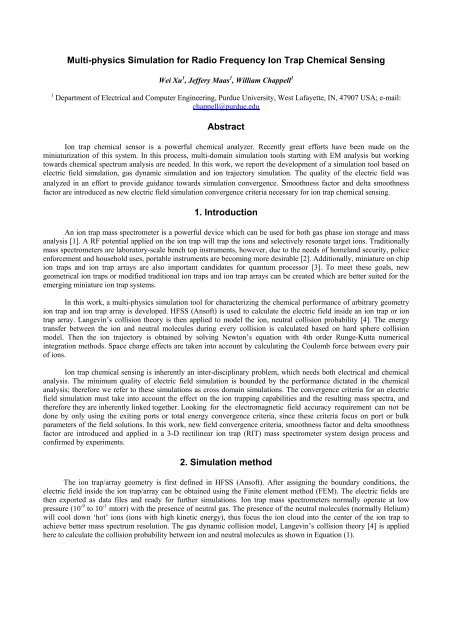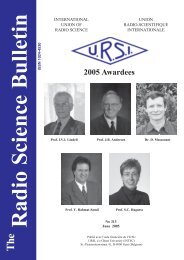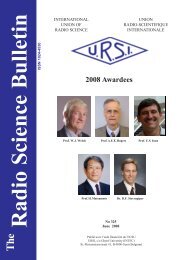Multi-physics Simulation for Radio Frequency Ion Trap ... - URSI
Multi-physics Simulation for Radio Frequency Ion Trap ... - URSI
Multi-physics Simulation for Radio Frequency Ion Trap ... - URSI
Create successful ePaper yourself
Turn your PDF publications into a flip-book with our unique Google optimized e-Paper software.
<strong>Multi</strong>-<strong>physics</strong> <strong>Simulation</strong> <strong>for</strong> <strong>Radio</strong> <strong>Frequency</strong> <strong>Ion</strong> <strong>Trap</strong> Chemical Sensing<br />
Wei Xu 1 , Jeffery Maas 1 , William Chappell 1<br />
1 Department of Electrical and Computer Engineering, Purdue University, West Lafayette, IN, 47907 USA; e-mail:<br />
chappell@purdue.edu<br />
Abstract<br />
<strong>Ion</strong> trap chemical sensor is a powerful chemical analyzer. Recently great ef<strong>for</strong>ts have been made on the<br />
miniaturization of this system. In this process, multi-domain simulation tools starting with EM analysis but working<br />
towards chemical spectrum analysis are needed. In this work, we report the development of a simulation tool based on<br />
electric field simulation, gas dynamic simulation and ion trajectory simulation. The quality of the electric field was<br />
analyzed in an ef<strong>for</strong>t to provide guidance towards simulation convergence. Smoothness factor and delta smoothness<br />
factor are introduced as new electric field simulation convergence criteria necessary <strong>for</strong> ion trap chemical sensing.<br />
1. Introduction<br />
An ion trap mass spectrometer is a powerful device which can be used <strong>for</strong> both gas phase ion storage and mass<br />
analysis [1]. A RF potential applied on the ion trap will trap the ions and selectively resonate target ions. Traditionally<br />
mass spectrometers are laboratory-scale bench top instruments, however, due to the needs of homeland security, police<br />
en<strong>for</strong>cement and household uses, portable instruments are becoming more desirable [2]. Additionally, miniature on chip<br />
ion traps and ion trap arrays are also important candidates <strong>for</strong> quantum processor [3]. To meet these goals, new<br />
geometrical ion traps or modified traditional ion traps and ion trap arrays can be created which are better suited <strong>for</strong> the<br />
emerging miniature ion trap systems.<br />
In this work, a multi-<strong>physics</strong> simulation tool <strong>for</strong> characterizing the chemical per<strong>for</strong>mance of arbitrary geometry<br />
ion trap and ion trap array is developed. HFSS (Ansoft) is used to calculate the electric field inside an ion trap or ion<br />
trap array. Langevin’s collision theory is then applied to model the ion, neutral collision probability [4]. The energy<br />
transfer between the ion and neutral molecules during every collision is calculated based on hard sphere collision<br />
model. Then the ion trajectory is obtained by solving Newton’s equation with 4th order Runge-Kutta numerical<br />
integration methods. Space charge effects are taken into account by calculating the Coulomb <strong>for</strong>ce between every pair<br />
of ions.<br />
<strong>Ion</strong> trap chemical sensing is inherently an inter-disciplinary problem, which needs both electrical and chemical<br />
analysis. The minimum quality of electric field simulation is bounded by the per<strong>for</strong>mance dictated in the chemical<br />
analysis; there<strong>for</strong>e we refer to these simulations as cross domain simulations. The convergence criteria <strong>for</strong> an electric<br />
field simulation must take into account the effect on the ion trapping capabilities and the resulting mass spectra, and<br />
there<strong>for</strong>e they are inherently linked together. Looking <strong>for</strong> the electromagnetic field accuracy requirement can not be<br />
done by only using the exiting ports or total energy convergence criteria, since these criteria focus on port or bulk<br />
parameters of the field solutions. In this work, new field convergence criteria, smoothness factor and delta smoothness<br />
factor are introduced and applied in a 3-D rectilinear ion trap (RIT) mass spectrometer system design process and<br />
confirmed by experiments.<br />
2. <strong>Simulation</strong> method<br />
The ion trap/array geometry is first defined in HFSS (Ansoft). After assigning the boundary conditions, the<br />
electric field inside the ion trap/array can be obtained using the Finite element method (FEM). The electric fields are<br />
then exported as data files and ready <strong>for</strong> further simulations. <strong>Ion</strong> trap mass spectrometers normally operate at low<br />
pressure (10 -9 to 10 -1 mtorr) with the presence of neutral gas. The presence of the neutral molecules (normally Helium)<br />
will cool down ‘hot’ ions (ions with high kinetic energy), thus focus the ion cloud into the center of the ion trap to<br />
achieve better mass spectrum resolution. The gas dynamic collision model, Langevin’s collision theory [4] is applied<br />
here to calculate the collision probability between ion and neutral molecules as shown in Equation (1).
Pr = e P αe<br />
2ε<br />
0<br />
KT μ<br />
(1)<br />
where, Pr is the probability of collision, m is the reduced mass of the ion, P is the pressure of the buffer gas, e is the ion<br />
charge, T is the temperature of the system, α e is the electron polarization of the buffer gas and ε 0 is the permittivity of<br />
air. The energy transfer between the ion and neutral particle is modeled by the hard sphere collision model, where we<br />
assume the collision is elastic and no internal energy is obtained inside ion or neutral molecule from the collision.<br />
The space charge effect which expands the ion cloud distribution is characterized by calculating the Coulomb<br />
<strong>for</strong>ce between every pair of charged particles. So as the ion number increases the total calculation time <strong>for</strong> this space<br />
charge effect will increase rapidly. The trajectory of ion motion is numerically obtained by solving the Newton’s<br />
Equation using 4-th order Runge Kutta integration. To minimize the numerical accumulative error during ion trajectory<br />
integration, the integration time step 1 ns is chosen. The electric field the ion feels from the trap is obtained by looking<br />
up the field solution exported from HFSS, and linear interpolation is made between grid points. The collision<br />
probability is calculated at the very beginning of the simulation. A random number is generated at every time step <strong>for</strong><br />
every ion and if this number is bigger than a threshold determined by the collision probability, a collision happens. The<br />
velocity changes of the ion because of this collision is calculated and set as the new velocity of this ion.<br />
3. Electric field convergence study<br />
Fig. 1 (a) demonstrates a typical ion trap <strong>for</strong> miniaturized mass spectrometers. This device, named a rectilinear<br />
ion trap, utilizes a quadrupolar pseudo potential well combined with a small percent of high order fields created by the<br />
application of RF voltage on a pair of electrodes to store or mass selectively ejects ions. In practice, the quality of the<br />
RF voltage signal is very important to provide a highly accurate spectrum. In simulation, this translates into the need <strong>for</strong><br />
highly accurate electric field simulations to accurately predict the per<strong>for</strong>mance of the designed ion trap. Also, the<br />
necessary field simulation quality in the electrical domain is determined by the ion trap per<strong>for</strong>mance in the chemical<br />
sensing domain, which makes this a cross domain problem and can not be solved by traditional convergence criteria (S<br />
parameter or delta energy, <strong>for</strong> instance).<br />
Fig. 1. Geometries of <strong>Ion</strong> <strong>Trap</strong>s. (a) Standard RIT instrumentation with dimensions 10×8×43.2 mm in X, Y and Z directions respectively,<br />
which is used in our 3-D simulation and experiment, (b) 2-D Rectilinear <strong>Ion</strong> <strong>Trap</strong> (RIT) model which is used as the simulation model in<br />
HFSS. Two PML are put at the front and back to cut the trap and mimic the infinite long RIT.<br />
With the challenge of highly accurate field simulation needs and the nature of an RIT field distribution as<br />
discussed in section II, we begin by considering an infinitely long rectilinear ion trap consisting of 4 plate electrodes<br />
separated by small isolation gaps, as shown in Fig. 1 (b). The use of the infinitely long rectilinear ion trap model allows<br />
the truncation of the simulation space without losing the functional RIT cross section field distribution. The infinite<br />
length is imitated by Perfect Magnetic Walls (PML) at the front and back cross sections. The truncated simulation space<br />
allows <strong>for</strong> dense mesh operations to test convergence criteria by allowing oversampling of the region and accurate<br />
determination of the level of convergence needed. The lessons learned from the cross sectional simulations will be<br />
applied to a full 3-D simulation and design process in later section.<br />
In Fig. 1 (b), the rectilinear ion trap dimensions were: a = 10 mm, b = 8 mm, the gap size g = 0.2 mm and w = 1<br />
mm. The sources were RF and DC voltages applied on the top and bottom plate electrodes. The electric field simulation<br />
was per<strong>for</strong>med several times with different mesh densities, from 8.6 to 2554 tetrahedra/mm 3 . This step by step<br />
progression of mesh densities allow us to determine how the mesh density will affect the field accuracy and furthermore
how the field accuracy will affect its applications, in our case the mass spectrum and ion trajectories. The solution of<br />
our finest mesh density (2554 tetrahedra/mm 3 ) corresponds to delta energy convergence below 10 -6 .<br />
The conventional field convergence criteria, like the S parameter and energy variations will not work well <strong>for</strong><br />
this ion trap chemical sensing application. Since the electric field in the center of the trap is critical <strong>for</strong> accurate ion<br />
tracing, however, the electric field at the corners of a RIT is much larger and dominates the above field convergence<br />
criteria. There<strong>for</strong>e, the field quality we are interested (the center of the trap) is not probed. Also, any Gaussian noise on<br />
the electric field (with zero averaged error) can not be seen either.<br />
Because of the problems discussed above, smoothness factor (Equation (3)) is introduced as convergence criteria<br />
to meet the special requirements in the cross domain ion trap chemical sensor designs.<br />
⎛ E0 ⊗ f −E<br />
⎞<br />
0<br />
Sm<br />
= mean<br />
(3)<br />
⎜ E ⎟<br />
⎝<br />
0 ⎠<br />
here E 0 is a simulated field solution under test, f is a spatial filter function and ‘ ⊗ ’ is the convolution operator. By<br />
applying a proper spatial filter (f), the high spatial frequency components of a numerical solution can be filtered while<br />
remaining the main part of the quadrupolar field. This definition of the smoothness factor tracks the normalized<br />
smoothness of the field, so high value field points (corner and outer regions in a RIT) will not dominate this<br />
convergence criterion.<br />
In an ef<strong>for</strong>t to monitor the convergence of a series of simulations in the electrical domain without an analytical<br />
solution, we introduce another factor, delta smoothness factor (∆S m ). It is defined as follows:<br />
Sm2 − Sm<br />
1<br />
Δ Sm<br />
=<br />
(4)<br />
M − M<br />
d2 d1<br />
where S m2 and S m1 are the smoothness factor from consecutive simulations and M d2 and M d1 are the respective mesh<br />
densities of the simulations. This factor gives the improvement of the smoothness of the field per increase in mesh<br />
density.<br />
4. Results<br />
Two different Gaussian filters are presented here to analyze the effects of different bandwidth filters on<br />
smoothness factor. We first define a 2-D broad Gaussian filter: window size in spatial domain 1.2 mm × 1.2 mm or<br />
4×10 -6 λ (λ, wavelength), standard deviation: 3; and a narrow 2-D Gaussian filter: window size 0.8 mm × 0.8 mm or<br />
2.67×10 -6 λ, standard deviation: 2.<br />
(a)<br />
(b)<br />
Fig. 2. Convergence of the smoothness factor and delta smoothness factor with the increase of mesh density.<br />
By increasing mesh density or field accuracy, the smoothness factor converges very well as plotted in Fig. 2 (a).<br />
Also <strong>for</strong> different bandwidth spatial filters, smoothness factors converge in both cases with different converged value,<br />
as expected. The plot in Fig. 2 (b) depicts the convergence of the delta smoothness factor with respect to the mesh
density. Different from smoothness factor, delta smoothness factor will converge to zero independent of the type of<br />
field simulation and spatial filter.<br />
To fully prove our conclusions from previous cross section simulations, we per<strong>for</strong>med a 3-D ion trap design and<br />
simulations with comparison to corresponding experimental results. A 10×8×43.2 mm rectilinear ion trap is designed<br />
with a gap of 1mm in both simulation and experiment, as shown in Fig. 1 (a). In the experiment, the electrodes were<br />
made of stainless steel and tested in a vacuum manifold using Electron Impact (EI) ionization method. The compound<br />
1,3-dichlorobenzene (Aldrich Chemical Co., Inc.) was leaked into the vacuum manifold to an indicated pressure of ca.<br />
8×10 -7 Torr. Helium was used as the buffer gas at a pressure of 5×10 -5 Torr. The spectrum of 1,3-dichlorobenze was<br />
acquired using a mass selective instability scan (Fig. 3).<br />
Fig. 3. 3-D simulation results and experimental result of 1,3-dichlorobenzene.<br />
We use different mesh densities in simulation setup to acquire different field convergence quality. In this time,<br />
two mesh densities were tested; they are 38.75 and 137.5 Tetrahedron/mm 3 , respectively. To compare the results with<br />
the 2-D cross section cases, a cross section of the field is exported at z=0 and the smoothness factor is calculated. By<br />
using the narrow Gaussian spatial filter, the delta smoothness factors of these simulated fields are calculated as 1.47×10 -<br />
4 . Previous simulation results indicate that the field with mesh density 137.5 is smooth enough and the mass spectrum<br />
standard deviation of the spectrum should be within one mass range, which is around 5 volts from simulation and<br />
experiment results.<br />
5. Conclusion<br />
In this work, a multi-domain simulation tool is developed <strong>for</strong> characterizing ion trap chemical sensing. Electric<br />
field simulation, gas dynamic simulation and motion tracing simulation are integrated together. New convergence<br />
criterions, smoothness factor (S m ) and delta smoothness factor (∆S m ), are introduced and applied in mass spectrometry<br />
applications. By using these parameters, we can tell both the smoothness and the convergence of the solution without<br />
knowing the physical field solution. Results show that these factors agree very well with the accuracy of the field and<br />
can indicate the convergence of the field solution in both electric field simulation domain and chemical sensing domain.<br />
6. References<br />
[1] P. Wolfgang, "Electromagnetic <strong>Trap</strong>s <strong>for</strong> Charged and Neutral Particles (Nobel Lecture)," Angewandte Chemie<br />
International Edition in English, vol. 29, pp. 739-748, 1990.<br />
[2] M. G. Blain, L. S. Riter, D. Cruz, D. E. Austin, G. Wu, W. R. Plass, and R. G. Cooks, "Towards the hand-held<br />
mass spectrometer: design considerations, simulation, and fabrication of micrometer-scaled cylindrical ion<br />
traps," International Journal of Mass Spectrometry, vol. 236, pp. 91-104, 2004.<br />
[3] D. Kielpinski, C. Monroe, and D. J. Wineland, "Architecture <strong>for</strong> a large-scale ion-trap quantum computer,"<br />
Nature, vol. 417, pp. 709-711, 2002.<br />
[4] F. A. Londry, R. L. Alfred, and R. E. March, "Computer simulation of single-ion trajectories in Paul-type ion<br />
traps," Journal of the American Society <strong>for</strong> Mass Spectrometry, vol. 4, pp. 687-705, 1993.
















